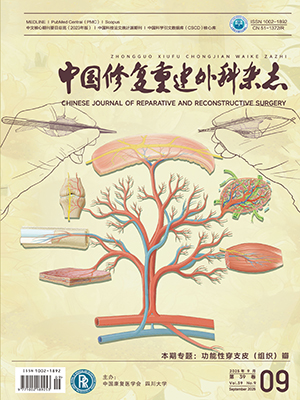Objective To explore the clinical value of repairing extensive gluteal-sacral defects with the posterior femoral cutaneous neurovascular island flap. Methods From July 2002 to May 2005, the posterior femoral cutaneous neurovascular flap was applied to repairing extensive gluteal-sacral defects in 6 patients (3 males, 3 females; aged 31-59 years). Threepatients had a skin defect in the gluteal-sacral region caused by squamous cell carcinoma, 1 patient had the defect in the same region caused by malignant fibrohistiocytoma, and 2 patients had the defect caused by bedsores of grade Ⅲ. The area of defects ranged from 15 cm×8 cm to 16 cm×10 cm.The flaps rangedin area from 15 cm×8 cm to 18 cm×10 cm. Results In all the 6 patients had their flaps survived well and the wounds gainedthe primary healing. The follow-up for 2.5-12 months revealed that, flaps were satisfactory in their appearance, texture, and sensory functions. Conclusion The repair of extensive gluteal-sacral defects with the posterior femoral cutaneous neurovascular island flap has advantages of the unchangedanatomic structures, reliable blood supply, easy dissection for extensive defects, good sensory recovery, and sacrificing no major vessels; therefore, this kind of repair is an optimal approach to repairing extensive glutealsacral defects.
Citation: QI Jian,LAO Zhenguo,ZHU Qingtang,et al.. REPAIR OF EXTENSIVE GLUTEALSACRAL DEFECT WITH POSTERIOR FEMORAL CUTANEOUS NEUROVASCULAR ISLAND FLAP. Chinese Journal of Reparative and Reconstructive Surgery, 2006, 20(12): 1205-1207. doi: Copy
Copyright © the editorial department of Chinese Journal of Reparative and Reconstructive Surgery of West China Medical Publisher. All rights reserved




